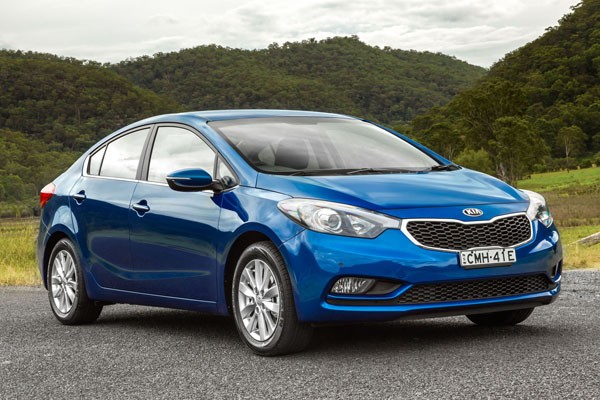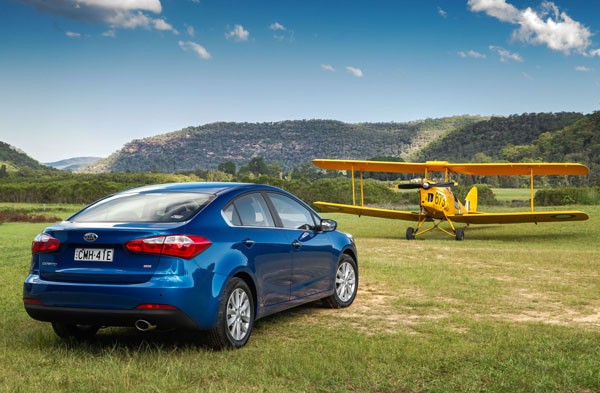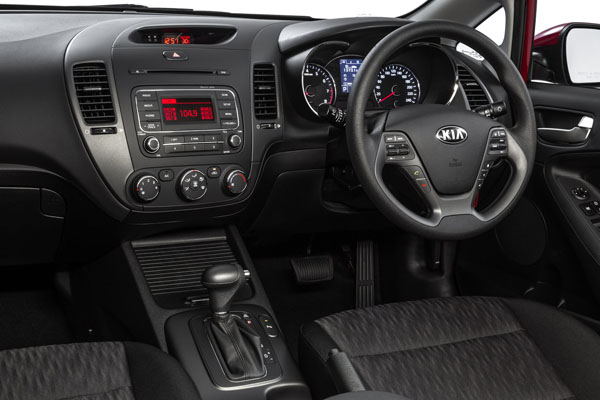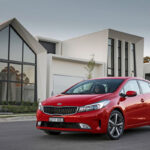
Style of the new Kia Cerato is dominated by the company’s now trademark grille, then flows neatly to the rear
The relentless march of the South Korean car industry continues. A combination of style, low prices and decent dynamics is proving attractive to an ever increasing numbers of Australian buyers.
Kia’s new Cerato sedan is a classic example. It is longer, wider, lower, with shorter overhangs than the second-generation car, all of which make for a sleeker styling with a fair touch of European in its shape
Clever design means the Cerato is lighter by around 50 kilograms, to help performance, reduce fuel consumption and trim exhaust emissions.
 Although it’s classified as a small car, we see the Kia Cerato is a genuine mid-sized family sedan. At 4.56 metres long it has enough legroom for two adults to sit comfortably in the rear, though the sleek styling means some may find rear headroom is marginal.
Although it’s classified as a small car, we see the Kia Cerato is a genuine mid-sized family sedan. At 4.56 metres long it has enough legroom for two adults to sit comfortably in the rear, though the sleek styling means some may find rear headroom is marginal.
The price of the entry-level Cerato S, at $19,990 plus on-road costs, gives you a lot of family car for a most modest outlay.
Kia Cerato S now has a smaller engine than before. Its new design 1.8-litre four-cylinder produces 110 kW of power and 178 Nm of torque. The previous entry level Cerato had a 2.0-litre (115 kW / 194 Nm) engine.

If you do want the larger engine you have to buy a Cerato Si or SLi. These have the 2.0-litre engine, now with numerous upgrades to lift it to 129 kW and 209 Nm.
All three Cerato models come with the choice of manual or automatic transmission, both with six forward speeds.
Inside the dashboard is simple, well-designed and functional.
We were most impressed with the solid feel of the gen-three Kia Cerato. It’s almost as good as many European cars. The new Cerato, like all Kias of the latest models sold in Australia, had a considerable amount of local input in the suspension and steering. While some of the early Aussie-modified Kias can be on the firm side, this new Cerato is impressively smooth in its ride, even over badly corrugated roads.
This added comfort may be due to the fact that the suspension guys have backed off a little on the sportiness of the Cerato. Resulting in handling that is safe rather than exciting. Which, we revhead road testers have to admit is what typical buyers expect from a car in this class.
As we’ve come to expect, Kia Cerato is well-equipped in the safety field. Standard on all models are Electronic Stability Control with traction control, ABS brakes, electronic brakeforce distribution and brake assist; and Emergency Stop Signal that activates the hazard lights on emergency braking. Six airbags help to keep you alive if the aforementioned protection electronics can’t prevent a crash.
On the luxury front, there’s cruise control, Bluetooth; Auxiliary and USB sockets; and steering wheel mounted controls in all models.
Kia Cerato Si not only gets the bigger engine it also has 16-inch alloy wheels; a reversing camera; smart key with push-button start/stop; chromed highlight surrounds. There’s what Kia terms a ‘premier’ interior trim; 4.3-inch LCD computer screen; and automatic lights.
The range-topping Cerato SLi scores 17-inch alloys; LED taillights; LED daytime running lights; leather trimmed seats; heated front seats; a powered driver’s seat; paddle-shifters when the automatic transmission is specified; and dual-zone climate control.
A satellite navigation package including traffic information and DVD player displaying on a 7-inch LCD screen, is priced at $1000.
Our road test car this week was the topline Kia Cerato SLi with an auto transmission, coming in at $29,990 plus on-roads. That’s a lot of car for a very reasonable outlay – just compare it to some Euro family sedans in the same class. However, it has to be admitted that the South Korean Kia sits a long way down the prestige scale from the iconic Europeans. Such is life.
The 2.0-litre engine has plenty of punch and the transmission generally responds with a minimum of hesitation when a lower gear is required. It’s a nice combination.
Fuel consumption around town was in the eight to nine litres per hundred kilometres range, which isn’t bad for a car of this size. On the open road it wasn’t difficult to get the petrol use under seven litres per hundred with careful driving.
At this stage only the Kia Cerato sedan has been introduced to Australia. A five-door hatch is expected within a few months.
An upgrade of the existing two-door coupe, the Kia Koup, will be released towards the end of the year.
Like all Kia models the new Cerato comes with a five year, unlimited kilometre warranty.
AT A GLANCE
MODEL RANGE
S 1.8-litre petrol four-door sedan: $19,990 (manual), $21,990 (automatic)
Si 2.0-litre petrol four-door sedan: $23,990 (manual), $25,990 (automatic)
SLi 2.0-litre petrol four-door sedan: $27,990 (manual), $29,990 (automatic)
Note: These prices do not include government or dealer delivery charges. Contact your local Kia dealer for driveaway prices.
FEATURES
ABS Brakes: Standard in all models
Automatic Transmission: $2000 option in all models
Cruise Control: Standard in all models
Dual Front Airbags: Standard in all models
Front Side Airbags: Standard in all models
Electronic Stability Program: Standard in all models
Rear Parking Sensors: Standard in all models
Reversing Camera: Not offered in S, standard in Si and SLi
USB/Auxiliary Audio Inputs: Standard in all models
Bluetooth: Standard in all models
Steering Wheel Mounted Controls: Standard in all models
SPECIFICATIONS (Kia Cerato S 1.8-litre petrol four-door sedan)
ENGINE:
Capacity: 1.797 litres
Configuration: Transverse, four cylinders in line
Head Design: DOHC, four valves per cylinder
Compression Ratio: 10.3:1
Bore/Stroke: 81.0 mm x 87.2 mm
Maximum Power: 110 kW @ 6500 rpm
Maximum Torque: 178 Nm @ 4700 rpm
DRIVELINE:
Driven Wheels: Front
Manual Transmission: Six-speed
Automatic Transmission: Six-speed
Final Drive Ratio: 4.188:1 (manual)
DIMENSIONS, WEIGHT AND CAPACITIES:
Length: 4560 mm
Wheelbase: 2700 mm
Width: 1780 mm
Height: 1435 mm
Turning Circle: 10.6 metres
Kerb Mass: 1287 kg
Fuel Tank Capacity: 50 litres
Towing Ability: 610 kg (1200 kg with braked trailer)
Boot Capacity: 482 litres
SUSPENSION AND BRAKES:
Front Suspension: MacPherson struts
Rear Suspension: Coupled torsion beam axle
Front Brakes: Ventilated disc
Rear Brakes: Disc
FUEL CONSUMPTION:
Type: Petrol 91RON
Combined Cycle (ADR 81/02): 6.6 L/100km
GREEN VEHICLE GUIDE RATINGS:
Greenhouse Rating: 7.5/10
Air Pollution Rating: 6.5/10
STANDARD WARRANTY
Five years/unlimited km











